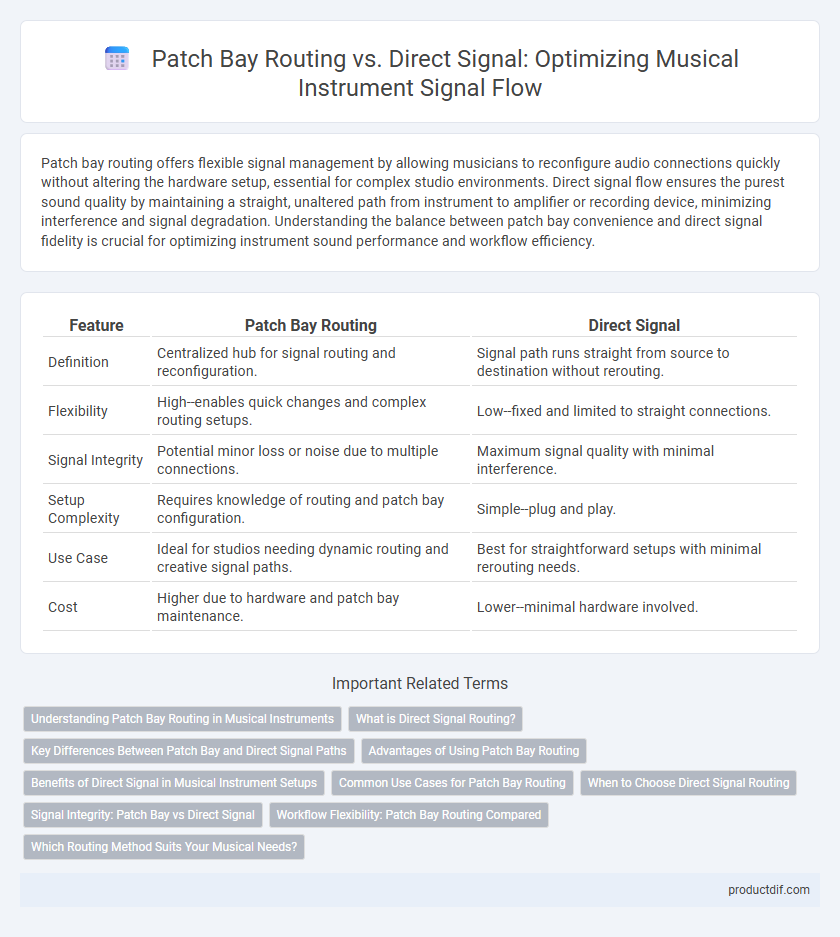Patch bay routing offers flexible signal management by allowing musicians to reconfigure audio connections quickly without altering the hardware setup, essential for complex studio environments. Direct signal flow ensures the purest sound quality by maintaining a straight, unaltered path from instrument to amplifier or recording device, minimizing interference and signal degradation. Understanding the balance between patch bay convenience and direct signal fidelity is crucial for optimizing instrument sound performance and workflow efficiency.
Table of Comparison
| Feature | Patch Bay Routing | Direct Signal |
|---|---|---|
| Definition | Centralized hub for signal routing and reconfiguration. | Signal path runs straight from source to destination without rerouting. |
| Flexibility | High--enables quick changes and complex routing setups. | Low--fixed and limited to straight connections. |
| Signal Integrity | Potential minor loss or noise due to multiple connections. | Maximum signal quality with minimal interference. |
| Setup Complexity | Requires knowledge of routing and patch bay configuration. | Simple--plug and play. |
| Use Case | Ideal for studios needing dynamic routing and creative signal paths. | Best for straightforward setups with minimal rerouting needs. |
| Cost | Higher due to hardware and patch bay maintenance. | Lower--minimal hardware involved. |
Understanding Patch Bay Routing in Musical Instruments
Patch bay routing in musical instruments enables flexible signal management by allowing multiple audio sources and destinations to be interconnected through a centralized panel. This system facilitates dynamic reconfiguration of signal paths without the need to physically disconnect and reconnect cables at each device, enhancing workflow efficiency in studios and live setups. Understanding patch bay routing involves recognizing its role in optimizing audio signal flow between instruments, processors, and mixers to maintain signal integrity and streamline sound engineering processes.
What is Direct Signal Routing?
Direct signal routing refers to the process of sending an audio signal straight from its source to a destination without any intermediate processing or alterations. This method ensures the purest sound quality by avoiding any potential coloration or latency that can occur with patch bay routing. Musicians and sound engineers often prefer direct signal routing for critical monitoring and recording tasks where signal integrity is paramount.
Key Differences Between Patch Bay and Direct Signal Paths
Patch bay routing offers flexible signal management by allowing multiple audio sources and destinations to be interconnected through a central hub, enabling quick reconfiguration without rewiring. Direct signal paths provide a straightforward, hardwired connection between instruments and audio devices, ensuring minimal signal loss and lower latency. The key difference lies in patch bays facilitating versatile routing options for complex setups, while direct signal paths prioritize simplicity and signal integrity.
Advantages of Using Patch Bay Routing
Patch bay routing enhances studio workflow by enabling flexible signal management and quick reconfiguration of audio paths without unplugging cables directly from instruments or mixers. This setup minimizes wear on connectors, preserving equipment longevity while streamlining complex routing tasks for recording, mixing, and live performances. Centralizing connections in a patch bay also facilitates easier troubleshooting and efficient integration of multiple instruments and outboard gear.
Benefits of Direct Signal in Musical Instrument Setups
Direct signal routing in musical instrument setups ensures a pure, uncolored audio path, preserving the original tone and dynamics of the instrument. By minimizing the risk of signal degradation and latency, it offers musicians real-time responsiveness crucial for live performance and recording. This method simplifies troubleshooting and reduces potential points of failure, enhancing overall system reliability.
Common Use Cases for Patch Bay Routing
Patch bay routing is commonly used in audio studios to organize and manage complex signal flows, allowing engineers to easily redirect signals between various instruments, effects, and recording devices without repatching cables. It facilitates quick changes in routing for live sound setups, multi-tracking sessions, and signal processing chains, enhancing workflow efficiency and reducing equipment wear. This system is particularly beneficial in environments requiring frequent reconfiguration, such as broadcast studios, live performance rigs, and modular synthesis setups.
When to Choose Direct Signal Routing
Direct signal routing is ideal when maintaining the purest audio quality without additional processing or latency is crucial, such as in live performances or critical recording sessions. It minimizes potential signal degradation by bypassing patch bays and external gear, preserving the original instrument tone and dynamics. Musicians and audio engineers prefer direct routing for straightforward, reliable signal paths where simplicity and fidelity are paramount.
Signal Integrity: Patch Bay vs Direct Signal
Patch bay routing can introduce slight signal degradation due to additional connectors and cables, potentially impacting signal integrity through increased noise and crosstalk. Direct signal paths maintain higher fidelity by minimizing connection points, preserving the original audio quality with less interference or signal loss. Choosing direct routing over patch bays is crucial for applications demanding pristine sound quality and minimal signal degradation.
Workflow Flexibility: Patch Bay Routing Compared
Patch bay routing enhances workflow flexibility by allowing quick and non-destructive signal reconfiguration across multiple audio devices without rewiring. Direct signal setups offer straightforward paths but limit adaptability and require physical cable changes for any modifications. This flexibility in patch bay routing optimizes studio efficiency and creative experimentation during music production.
Which Routing Method Suits Your Musical Needs?
Patch bay routing offers flexible signal management by allowing quick reconfiguration of audio paths, making it ideal for complex studio setups requiring frequent changes. Direct signal routing ensures minimal signal degradation and latency, preferred in live performance or recording situations demanding pristine audio quality. Choosing the right method depends on whether adaptability or signal integrity is the priority in your musical workflow.
Patch Bay Routing vs Direct Signal Infographic

 productdif.com
productdif.com